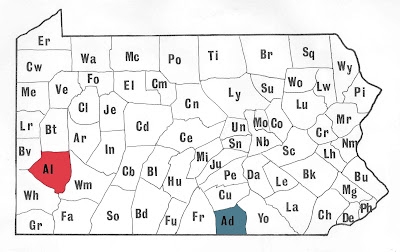This week we travel across the state to southwestern Pennsylvania to Allegheny County. This heavily populated county is home to Pittsburgh and all that great city has to offer- Heinz History Center, Fort Pitt Museum, Carnegie Museum, Point State Park and oh yeah, the Pittsburgh Steelers. Despite construction and development in this metropolitan area, there are 625 archaeological sites recorded. These sites range from the Paleoindian period to 20th century farmsteads, each of them with a unique piece of our heritage.
Allegheny County was an important location during the French & Indian War, situated strategically at the forks of the Ohio River this location was sought as a supply route by both the French and British troops. French troops needed the connection to allow for supplies from the northern territories to come down French Creek into the Allegheny River to transport goods to French controlled lands in the Louisiana Territory. British troops sought control of this territory to allow for western expansion and control of the fur trade. It comes then as no surprise that seven military sites are located in Allegheny County, including Fort Pitt. Built by the British after the French were forced from Ft. Duquesne, this was the largest fort of the period and served as a stronghold in securing the Ohio Valley. Excavations conducted during the 1940’s and 1950’s at this important site produced timbers from the stockade walls surrounding the fort. Newspaper accounts of these excavations stirred public interest and enthusiasm for the preservation and reconstruction of the fort property.
 |
| Newspaper accounts of excavations during the 1940's at Fort Pitt. |
Native peoples occupied this location long before it was sought by the French and British and roughly sixty-two percent of the sites recorded in the site survey files are from prehistoric sites. One of these sites, Wexford (36Al187) was discovered during an archaeological investigation prior to new construction. Testing and subsequent excavations by Christine Davis Consultants produced carbonized botanicals including seeds, pits and wood fibers. Charcoal recovered was analyzed as white oak as a result of a single-burn episode.
 |
| Careful excavation of features at Wexford site produced botanical remains for analysis. |
 |
| A nutting stone exhibits use by Native peoples in processing nuts. |
 |
| Bottle recovered from North Shore project- hands joined in union. |
 |
| Pittsburgh manufacturing bottles |
 |
| Excavation area preserved underneath paved surfaces of the urban surrounding. |
We hope you’ve enjoyed this glimpse into the archaeology of Allegheny County and hope that it inspires you to learn more about the archaeology of your county. These resources are Pennsylvania’s heritage and for all of us it is our window into the past. Please help us in preserving these important resources by reporting and recording your archaeological finds while we all Preserve our Past for the Future.
For more information, visit PAarchaeology.state.pa.us or the Hall of Anthropology and Archaeology at The State Museum of Pennsylvania .


No comments:
Post a Comment